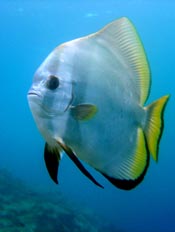Ocean Stories
 Life at the Poles
Life at the Poles
You probably know that the Earth’s poles are cold, cold, cold. But did you know that there are hundreds of organisms especially adapted to living in these extremes? Or that human communities, even those far away, affect temperatures and critters at both poles?
 Life in the Sand
Life in the Sand
Soft sand, gentle waves, seaweed, and scattered shells. The beach brings to mind a relaxing place to sit with family and friends, sinking your feet into the warm sand. You may not realize it, but those tiny grains of sand are important. They support a diverse world of microscopic critters and are a big part of what makes a beach, a beach.
 A Living Coral Reef
A Living Coral Reef
In the Sant Ocean Hall, you'll see fabulous fossils, amazing preserved specimens, and models. But one corner of the hall will be teeming with life - the living coral reef ecosystem! The organisms in this aquarium, grown and collected in a sustainable manner, will give you a taste of the diversity found on wild reefs. You’ll also learn why coral reefs are important and how they are threatened by overharvesting for the aquarium trade, rising temperatures, run-off and other pollution.
 Salmon Shape a Way of Life
Salmon Shape a Way of Life
You may think of salmon as a good choice for dinner, or enjoy it smoked and sliced on a bagel. But that salmon on your plate has a long and illustrious history – and an uncertain future. Salmon fisheries have drastically declined due to deteriorating habitat, over-harvesting, and dams that prevent the fish from reaching their breeding grounds. As stocks crash and fisheries are closed, Native American communities that depend on salmon for sustenance and cultural traditions are working with governments to save this resource.
 The Giant Squid
The Giant Squid
There will be many strange and wonderful animals to meet in the Sant Ocean Hall, but perhaps none as mysterious and thrilling as the giant squid. Not seen alive by human eyes until just a few years ago, the giant squid has spawned fantastic stories and myths of huge, hungry, many-tentacled sea creatures.
 Meet Basilosaurus, an Ancient Whale
Meet Basilosaurus, an Ancient Whale
In the Sant Ocean Hall, you will have a chance to meet several ocean-going precursors to and relatives of modern whales, including the mighty Basilosaurus. Originally given this name – which means “king lizard” – because it was mistaken for a giant sea serpent, Basilosaurus was a creature more than 55 feet (16 meters) long.
[ TOP ]
